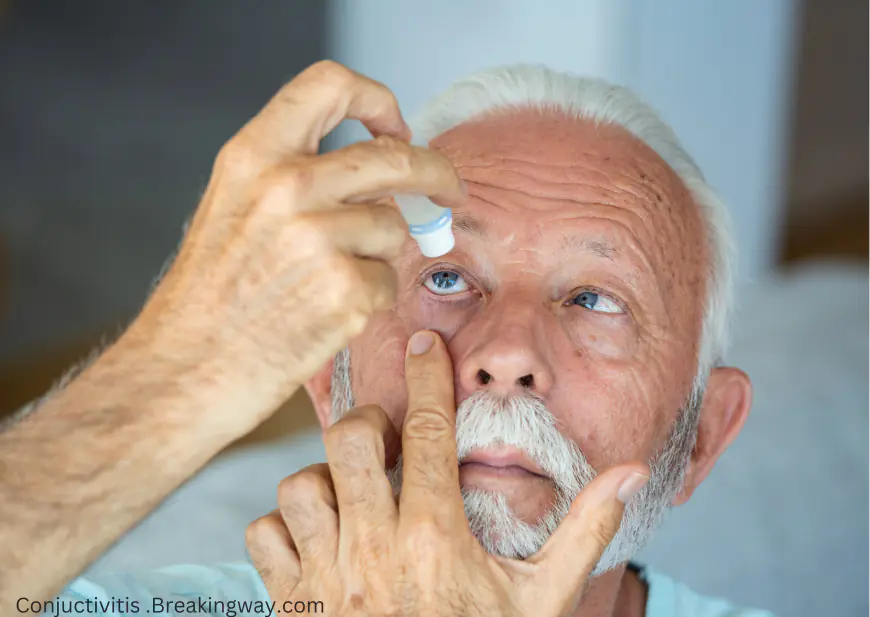Everything You Need to Know About Conjunctivitis (Pink Eye)
Learn all about conjunctivitis (pink eye) symptoms, causes, and treatment options to protect your eye health. Read more on Breaking Way.

Conjunctivitis, also known as pink eye, is a common eye condition characterized by inflammation of the transparent layer covering the white part of the eye and lining the inside of the eyelids. This inflammation can result from various causes including viruses, bacteria, and allergies. Although conjunctivitis can be bothersome, it is rarely serious. In this article, we will explore the causes of conjunctivitis, its symptoms, treatment options, and preventive measures you can take to avoid this condition.

Causes of Conjunctivitis:
- Viral Conjunctivitis: Viruses are the most common cause of conjunctivitis. Adenoviruses are the primary culprits, particularly serotypes 3, 4, and 7. These viruses spread easily in crowded environments such as schools and daycare centers.
- Bacterial Conjunctivitis: Bacterial conjunctivitis can be caused by various types of bacteria such as Staphylococcus and Streptococcus. Bacteria can enter the eye through contact with dirty hands or contaminated items such as makeup or contact lenses.
- Allergic Conjunctivitis: Allergic conjunctivitis occurs as a reaction to allergens such as pollen, dust mites, or chemicals in cosmetics. Allergic reactions cause inflammation in the conjunctiva due to the immune system's response to allergens.
- Injuries Leading to Conjunctivitis: Eye injuries, whether from a foreign body or scratches, can also lead to conjunctivitis. Environmental factors such as pollution can also contribute to eye irritation and inflammation.

Symptoms of Conjunctivitis:
- Redness of the Eye: Redness is a primary symptom of pink eye and occurs due to increased blood flow to the blood vessels in the eye.
- Photosensitivity in Conjunctivitis: Conjunctivitis can lead to heightened sensitivity to light, causing discomfort when exposed to bright lights.
- Excessive Tearing Due to Conjunctivitis: Excessive tearing is a natural response as the eye tries to flush out irritants.
- Eye Pain in Conjunctivitis: Mild to moderate eye pain can occur, often accompanied by itching, particularly in cases of allergic conjunctivitis.
- Discharge from the Eye: Conjunctivitis may cause clear discharge, or in bacterial cases, yellowish or greenish sticky discharge.
- Feeling of a Foreign Body in the Eye: Individuals may feel like there is something stuck in the eye, increasing discomfort, a common symptom in both viral and bacterial conjunctivitis.
- Eyelid Swelling in Conjunctivitis: Inflammation can cause the eyelid to swell, making the eye appear puffy, often seen in allergic and bacterial conjunctivitis
- Spread of Conjunctivitis Infection: The infection may start in one eye and spread to the other,especially if proper precautions are not taken.

Treatment of Conjunctivitis:
Conjunctivitis usually resolves on its own within two to four weeks, but the following measures can help alleviate symptoms:
- Apply Cold Compresses for Conjunctivitis Relief: Applying cold compresses to the eyes can reduce inflammation and soothe discomfort.
- Use Artificial Tears to Treat Conjunctivitis: Artificial tears can help keep the eyes lubricated and relieve dryness associated with the condition.
- Antihistamine Drops or Tablets for Allergic Conjunctivitis: For allergic conjunctivitis, antihistamine eye drops or tablets may be effective in reducing symptoms.
- Antibiotics for Bacterial Conjunctivitis: For bacterial conjunctivitis, antibiotics in the form of drops or ointments may be prescribed by a doctor.
- Avoid Irritants to Prevent Conjunctivitis: Avoiding irritants such as pollutants or chemical substances can help reduce exacerbation of the condition.
Prevention of Conjunctivitis:
To prevent conjunctivitis, consider the following tips:
- Regular Hand Washing to Prevent Conjunctivitis: Maintain hand hygiene by washing with soap and water or using hand sanitizer, and avoid touching your eyes.
- Disinfect Surfaces to Avoid Conjunctivitis: Clean and disinfect surfaces that may be contaminated, such as desks and personal items.
- Avoid Sharing Items to Prevent Conjunctivitis: Do not share personal items like makeup, towels, and contact lenses.
- Proper Contact Lens Care to Prevent Conjunctivitis: Ensure regular cleaning and disinfecting of contact lenses, and avoid using them if an eye infection is present.
- Protect Your Eyes from Irritants: Minimize exposure to environmental irritants like smoke and dust to prevent triggering conjunctivitis.
Conjunctivitis is a common but usually mild condition that can cause discomfort. By following the advice in this article, you can reduce your risk of developing conjunctivitis and keep your eyes healthy. If you experience any of the symptoms mentioned, it is important to consult a doctor to determine the appropriate treatment and ensure complete recovery.
What's Your Reaction?
















































